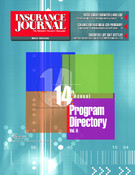How Program Managers Can Avoid the ‘Courthouse Blues’
A little old lady from San Francisco rejected an earthquake endorsement on her homeowners’ coverage, only to have her home later destroyed by earthquake. Her family sued the agent, the case went to trial and the jury ruled in favor of the lady.
In their role as insurance intermediaries, insurance agents, brokers, managing general agents and managing general underwriters are in a uniquely vulnerable position to be sued for errors and omissions exposures. Thus, individuals and businesses need insurance coverage to live and operate. If there is no coverage and if they are sued, they can become “cornered animals” looking for any “deep pocket” to cover the claim.
However, there are some basic steps insurance intermediaries can take to protect themselves against E&O exposures, according to Greg Katz and Tom Wilson Jr. of the Wilson Elser law firm in New York.
The two attorneys shared their E&O tips during the annual Target Markets Program Administrators Summit in Tempe, Ariz.
Typical liability exposures for intermediaries include all forms of negligence, including breach of contract, negligent misrepresentation, breach of fiduciary duty, failure to advise and failure to procure insurance, they said.
Besides the insureds themselves, potential plaintiffs include insurers and third parties including life insurance beneficiaries, additional insureds and others. Although cases like those are usually corrected in the appellate process, they are costly and stressful, and they can be avoided, Katz and Wilson noted.
The adoption of a “best practices” documentation system is key. “A well-documented file is your best defense,” Katz said. Even the addition of a simple disclaimer on all policyholder documentation, while not total protection against litigation, will help your case, he said.
Documentation also means having an operating process in place that is understood and practiced by everyone on staff. Internal quality control should cover everything including handling telephone inquiries, correspondence, applications, and filling out applications and other documents. Especially at issue are policyholder rejection of coverage and higher limits, which must be signed off on to “prevent insured amnesia,” Wilson noted.
Like lawyers and doctors, agents have a “standard of care” for their clients. Unfor-tunately, this is not as clearly understood as the Hippocratic Code because there is no written list of standards. Most problems and E&O exposures arise from communication problems, failure to take action, insufficient product know-ledge and insufficient control of agency staff, Wilson and Katz said.
Taking and documenting simple steps can make a big difference-for instance, actually going out and inspecting an insured property, acting on non-renewals, and responding to claims and demands in a timely way.
Among its plans for 2005 and beyond, TMPAA and its 31 carrier partners plan to begin awarding a “TMPAA Best Practices Designation” early next year. Information gathered from TMPAA’s 130-member agencies resulted in a partnership with Darwin Professional Underwriters to provide premium discounts and loss control evaluations for member errors and omissions coverage.
TMPAA also is developing an education program to meet members’ needs at all levels of program business operation.
Topics Agencies
Was this article valuable?
Here are more articles you may enjoy.


 Harvard Study Again Stirs the Pot on Demotech Ratings of Florida Carriers
Harvard Study Again Stirs the Pot on Demotech Ratings of Florida Carriers  US Dog-Related Injury Claims Hit $1.12 Billion in 2023: Triple-I, State Farm Report
US Dog-Related Injury Claims Hit $1.12 Billion in 2023: Triple-I, State Farm Report  Coral Gables, Florida Tops Beverly Hills as Ritziest Home Market in US
Coral Gables, Florida Tops Beverly Hills as Ritziest Home Market in US  Employers Can’t Use Vicarious Liability to Block Negligence Claims, TN High Court Says
Employers Can’t Use Vicarious Liability to Block Negligence Claims, TN High Court Says 


